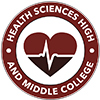Student Health & Safety
HSHMC is committed to supporting the mental and emotional wellness of our students as these barriers can impact student success. Access to community pupil mental health services and resources is made available through the list below.
Mental Health Wellness
HSHMC is committed to supporting the mental and emotional wellness of our students as these barriers can impact student success. Access to community pupil mental health services and resources is made available through the list below.
- 211 San Diego
- Center for Community Counseling and Engagement
- Crisis Hotline: 888-724-7240
- Directory of Behavioral Health Services Providers
- It’s Up to Us
- Mental Health America of San Diego County
- National Alliance on Mental Illness (NAMI) San Diego
- National Suicide Prevention Lifeline – 1-800-273-TALK
Synthetic Drug/Fentanyl Abuse
Across the nation – and in our own San Diego County – the dangerous drug fentanyl is becoming more and more prevalent. We want our families to be informed, know the warning signs, and partner with us to communicate the dangers of fentanyl to your children.
According to the Centers for Disease Control and Prevention (CDC), overdose deaths among teenagers linked to synthetic opioids like fentanyl tripled in the past two years, yet 73 percent have never heard of fake prescription pills being made with fentanyl.
Prevention and response efforts at HSHMC
While we hope the situation does not take place, our school is prepared to respond if an overdose occurs on campus. HSHMC is equipped with two doses of naloxone, a medication that reverses an opioid overdose, and has at least three staff members trained in how to administer it.
What is Fentanyl?
There are two types of fentanyl: medical grade (prescribed by a doctor) and illegally made (illicit). In medical settings, fentanyl is used as a pain reliever like oxycodone and morphine.
However, illicit fentanyl is a potent synthetic opioid made in a lab that is up to 50 times stronger than heroin and 100 times stronger than morphine. Just a few grains of sand worth can be lethal.
Why Should I Care?
Fentanyl is very cheap and extremely addictive. Drug dealers are dangerously mixing illicit fentanyl with, and disguising it, as other common drugs like oxycontin, Percocet and Xanax to increase profits. This process is not regulated and does not undergo any kind of quality control. As little as two milligrams of fentanyl (two grains of sand) can kill a person.
Fentanyl is everywhere: an estimated 250-500 million pills made with fentanyl are in circulation in the U.S. at any time, not including powder drugs made with fentanyl such as cocaine, MDMA (molly/ecstasy), or heroin.
The practice of cutting drugs with fentanyl is relatively new, so public awareness is low. Educating the public about this crisis is the first step to reversing the tragic outcomes.
What are the Facts?
Fentanyl is often found in non-pharmaceutical made pills that look like, and are sold as oxycontin Percocet, Xanax, Vicodin, cocaine and more.
Fentanyl is extremely potent. As little as two milligrams of fentanyl, an amount equal to two grains of sand, can kill a person.
Fentanyl is involved in more deaths of Americans under 50 than any other cause of death, including heart disease, cancer, and all other accidents.
Any “prescription” pill you don’t directly get from a pharmacy, or any powder form drugs purchased from a friend/drug dealer, may contain a lethal dose of fentanyl. Real prescription drugs are not available on Instagram or Snapchat. These drugs are not regulated.
What Can I Do?
Know the signs of an overdose: Loss of consciousness, unresponsiveness, irregular breathing, and inability to speak are a few of the signs to look out for.
Be prepared to call for help: If you witness someone experiencing the symptoms of an overdose, call 911 and request emergency medical services. California has enacted Good Samaritan laws, which provide immunity to those who call emergency services when experiencing or witnessing an overdose.
What is naloxone/Narcan?
Naloxone (also known as Narcan®) is a medication called an “opioid antagonist” used to counter the effects of opioid overdose. Naloxone has no potential for abuse. It is a temporary drug sprayed up the nose that wears off in 20-90 minutes.
Narcan is used in overdoses to counteract life-threatening central nervous system and respiratory system issues, allowing an overdose victim to breathe normally.
Often administered by emergency response personnel, naloxone can actually be administered by minimally trained laypeople including nurses, teachers, police officers and students.
The Naloxone Distribution Project provides free Naloxone to schools and universities at no cost.
Resources
- San Diego County Prescription Drug Abuse Task Force website
- San Diego County Office of Education website
- Community & Parent Toolkits: Education & Awareness
- National Harm Reduction Center: Recognizing Opioid Overdose
- Up2SD.org
- California Department of Public health: Naloxone FAQ
If you need help with substance abuse or if you suspect a friend or loved one needs help, call the free, confidential 24/7 San Diego County Access and Crisis Line at 888-724-7240. You can also call 2-1-1 for substance use and mental health treatment referrals.

Human Trafficking Prevention Information
Disclaimer: The webpages listed below contain information about sexuality and have been reviewed and recommended by HSHMC. Secondary links or websites found on these recommended webpages have not been reviewed by HSHMC.

